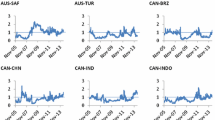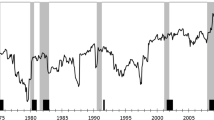Abstract
In this paper, we examine the price discovery and volatility spillovers among equity markets of eight emerging market economies (EMEs)—Brazil, China, India, Indonesia, Mexico, Russia, South Africa and Turkey—from January 2003 to July 2014, covering the 2007–2009 global financial crisis (GFC). The analysis is conducted for pre-crisis, crisis and post-crisis periods. The results of price discovery indicate that Brazil leads in pre-crisis period while South Africa leads during crisis period. No single market is dominant in the post-crisis period and across the full sample period as well. Dynamic cointegration test largely confirms the findings from the static Johansen’s cointegration test. Employing asymmetric dynamic conditional correlation and BEKK-GARCH models, we find that volatility spillovers reduced among the sample markets over time. The empirical results suggest that the information linkages among the sample EMEs’ equity markets weakened during the GFC and did not revert to stable period levels after the crisis. The findings have implications for policy makers and investors.


Similar content being viewed by others
Notes
‘BRIC’ in 2006 became ‘BRICS’ in 2011 after including South Africa.
According to the IMF’s World Economic Outlook of April 2014, emerging market risks have increased, highlighting market concern about emerging market fundamentals.
Referred to as the ‘Goldilocks era’ by Goldman Sachs, whereby a Goldilocks economy is one that is not so hot that it causes inflation and not so cold that it causes a recession. For instance, the US economy of the mid- to late-1990s was considered a Goldilocks economy because it was “not too hot, not too cold, but just right.”
Other groupings include Asian Economic Community (AEC), Gulf Cooperation Council (GCC), Shanghai Cooperation Organization (SCO) and USAN (Union of South American Nations).
IBSA stands for India, Brazil and South Africa. CIVETS comprises of Colombia, Indonesia, Vietnam, Egypt, Turkey and South Africa. MINT stands for Mexico, Indonesia, Nigeria and Turkey. The NEXT-11 countries include Bangladesh, Egypt, Indonesia, Iran, Mexico, Nigeria, Pakistan, the Philippines, Turkey, South Korea and Vietnam.
Financial contagion literature suggests correlations among stock markets increase during a crisis period. Forbes and Rigobon (2002) define increase in cross-market linkages following an economic shock in one country, as ‘shift-contagion.’ Distinguishing between contagion and interdependence, they write that while the former relates to cross-market linkages being fundamentally different after a shock to one market, the latter implies no significant changes in relationships despite shocks hitting the recipient market.
As per World Development Indicators, World Bank 2012, http://data.worldbank.org/indicator/CM.MKT.LCAP.GD.ZS/countries?order=wbapi_data_value_2012+wbapi_data_value+wbapi_data_value-last&sort=desc.
The Guardian (http://www.theguardian.com/business/2012/aug/07/credit-crunch-boom-bust-timeline) and the BBC (http://news.bbc.co.uk/2/hi/business/7521250.stm) timelines corroborate this.
Results of stationarity testing are available upon request.
According to Fung et al. (2008), a wider window of three years is better to capture the long-run relationship in the cointegration measure.
The Foreign Ministers of the BRIC countries first met on the sidelines of the 61st General Assembly of the United Nations on September 23, 2006. South Africa was invited to attend the 3rd BRICS Summit in Sanya on April 14, 2011.
South Africa was ranked 53rd (out of 148 countries) in the Global Competitiveness Index of September 2013 by World Economic Forum.
In 2011, India was the 11th largest trading partner of China, 7th largest export destination for China and 16th largest exporter to China.
Insight on ‘Emerging Markets: As the Tide Goes Out,’ Investment Strategy Group in the Investment Management Division of Goldman Sachs, December 2013 (http://www.goldmansachs.com/what-we-do/investment-management/private-wealth-management/intellectual-capital/isg-insight-2013.pdf).
References
Abbas Q, Khan S, Shah SZ (2013) Volatility transmission in regional Asian stock markets. Emerg Mark Rev 16:66–77
Ahmad W, Sehgal S (2015) Regime shifts and volatility in BRIICKS stock markets: an asset allocation perspective. Int J Emerg Mark 10(3):383–408
Ahmad W, Sehgal S, Bhanumurthy N (2013) Eurozone crisis and BRIICKS stock markets: Contagion or market interdependence? Econ Model 33:209–225
Al Nasser OM, Hajilee M (2016) Integration of emerging stock markets with global stock markets. Res Int Bus Finance 36(C):1–12
Angelini P, Nobili A, Picillo C (2011) The interbank market after August 2007. What has changes, and why? J Money Credit Bank 43(5):923–958
Asongu SA (2012) Globalization, financial crisis and contagion: time-dynamic evidence from financial markets of developing countries. J Adv Stud Finance 2(3):131–139
Awartani B, Maghyereh AI, Al Shiab M (2013) Directional spillovers from the US and the Saudi market to equities in the Gulf Cooperation Council countries. J Int Financial Mark Inst Money 27:224–242
Bajpai N (2011) Global financial crisis, its impact on India and the policy response. Working Paper No. 5, Columbia Global Centers, South Asia, Columbia University
Barba FG, Ceretta PS (2011) Risk transmission between Latin America stock markets and the US: impacts of the 2007/2008 crisis. Econ Bull 31(2):1025–1037
Bhar R, Nikolova B (2007) Analysis of mean and volatility spillovers using BRIC countries, regional and world equity returns. J Econ Integr 22(2):369–381
Caporale GM, Spagnolo N (2012) Stock market integration between three CEECs. J Econ Integr 27(1):115–122
Cappiello L, Engle R, Sheppard K (2006) Asymmetric Dynamics in the Correlations of Global Equity and Bond Returns. J Finance Econom 4:537–572
Chen G-M, Firth M, Rui OM (2002) Stock market linkages: evidence from Latin America. J Bank Finance 26:1113–1141
Chen H, Lobo BJ, Wong W-K (2007) Globalization and emerging stock market integration: evidence from a FIVECM-MGARCH model. Working Paper, pp 1–26
Choudhry T (1997) Stochastic trends in stock prices: evidence from Latin American markets. J Macroecon 19(2):285–304
Christofi A, Pericli A (1999) Correlation in price changes and volatility of major Latin American stock markets. J Multinatl Financ Manag 9:79–93
Click R, Plummer M (2005) Stock market integration in ASEAN after the Asian financial crisis. J Asian Econ 16(1):5–28
Engle RF (2002) Dynamic conditional correlation: a simple class of multivariate generalised autoregressive conditional heteroskedasticity models. J Bus Econ Stat 20(3):339–350
Engle RF, Kroner KF (1995) Multivariate simultaneous generalized ARCH. Econ Theory 11(1):122–150
Forbes KJ, Rigobon R (2002) No contagion, only interdependence: measuring stock market comovements. J Finance 57:2223–2261
Fung LK-P, Tam C-S, Yu I-W (2008) Assessing the integration of Asia’s equity and bond markets. BIS Paper No. 42
Gilmore CG, Lucey BM, McManus GM (2008) The dynamics of Central European equity market comovements. Q Rev Econ Finance 48:605–622
Glick R, Hutchison M (2013) China’s financial linkages with Asia and the global financial crisis. J Int Money Finance 39:186–206
Hashmi A, Xingyun L (2001) Interlinkages among South East Asian stock markets (A comparison between pre- and post-1997-crisis periods). Working Paper presented at the 10th International Tor Vergata Financial Conference, Dec 2001
Johansen S (1991) Estimation and Hypothesis testing of cointegration vectors in gaussian vector autoregressive models. Econometrica 59(6):1551–1580
Johansson AC, Ljungwall C (2009) Spillover effects among the greater China stock markets. World Dev 37(4):839–851
Kaur H (2004) Time varying volatility in the Indian stock market. Vikalpa 29(4):25–42
Kim B-H, Kim H, Lee B-S (2015) Spillover effects of the US financial crisis on financial markets in emerging Asian countries. Int Rev Econ Finance 39:192–210
Kyle A (1985) Continuous auction and insider trading. Econometrica 53:1315–1335
Lahmiri S (2015) Long memory in international financial markets trends and short movements during 2008 financial crisis based on variational mode decomposition and detrended fluctuation analysis. Physica A 437:130–138
Mylonidis N, Kollias C (2010) Dynamic European stock market convergence: evidence from rolling cointegration analysis in the first euro-decade. J Bank Finance 34:2056–2064
Neaime S (2012) The global financial crisis, financial linkages and correlations in returns and volatilities in emerging MENA stock markets. Emerg Mark Rev 13:268–282
Nelson D (1991) Conditional heteroskedasticity in asset returns. Econometrica 59(2):347–370
Nikkinen J, Saleem K, Martikainen M (2013) Transmission of the subprime crisis: evidence from industrial and financial sectors of BRIC countries. J Appl Bus Res 29(5):1469–1478
Palamalai S, Kalaivani M, Devakumar C (2013) Stock market linkages in emerging Asia–Pacific markets. SAGE Open 3:1–15
Pascual AG (2003) Assessing European stock markets (co)integration. Econ Lett 78:197–203
Roca ED, Selvanathan EA, Shepherd WF (1998) Are the ASEAN equity markets interdependent? ASEAN Econ Bull 15(2):109–120
Sehgal S, Jain P, Deisting F (2016) Information transmission between mature and emerging equity markets during normal and crisis periods: an empirical examination. J Quant Econ. doi:10.1007/s40953-016-0067-y
Trichet J-C (2010) State of the union: the financial crisis and the ECB’s response between 2007 and 2009. J Common Mark Stud 48:7–19
Wang L (2014) Who moves East Asian stock markets? The role of the 2007–2009 global financial crisis. J Int Financ Mark Inst Money 28:182–203
Xiao L, Dhesi G (2010) Volatility spillover and time-varying conditional correlation between the European and US stock markets. Glob Econ Finance J 3:148–164
Yang J, Kolari J, Min I (2003) Stock market integration and financial crises: the case of Asia. Appl Financ Econ 13(7):477–486
Zhang B, Li X, Yu H (2013) Has recent financial crisis changed permanently the correlations between BRICS and developed stock markets? North Am J Econ Finance 26:725–738
Zhou X, Zhang W, Zhang J (2012) Volatility spillovers between the Chinese and world equity markets. Pac Basin Finance J 20:247–270
Author information
Authors and Affiliations
Corresponding author
Rights and permissions
About this article
Cite this article
Sehgal, S., Jain, P. Information linkages among emerging equity markets—an empirical study. Decision 44, 15–38 (2017). https://doi.org/10.1007/s40622-016-0144-2
Published:
Issue Date:
DOI: https://doi.org/10.1007/s40622-016-0144-2




